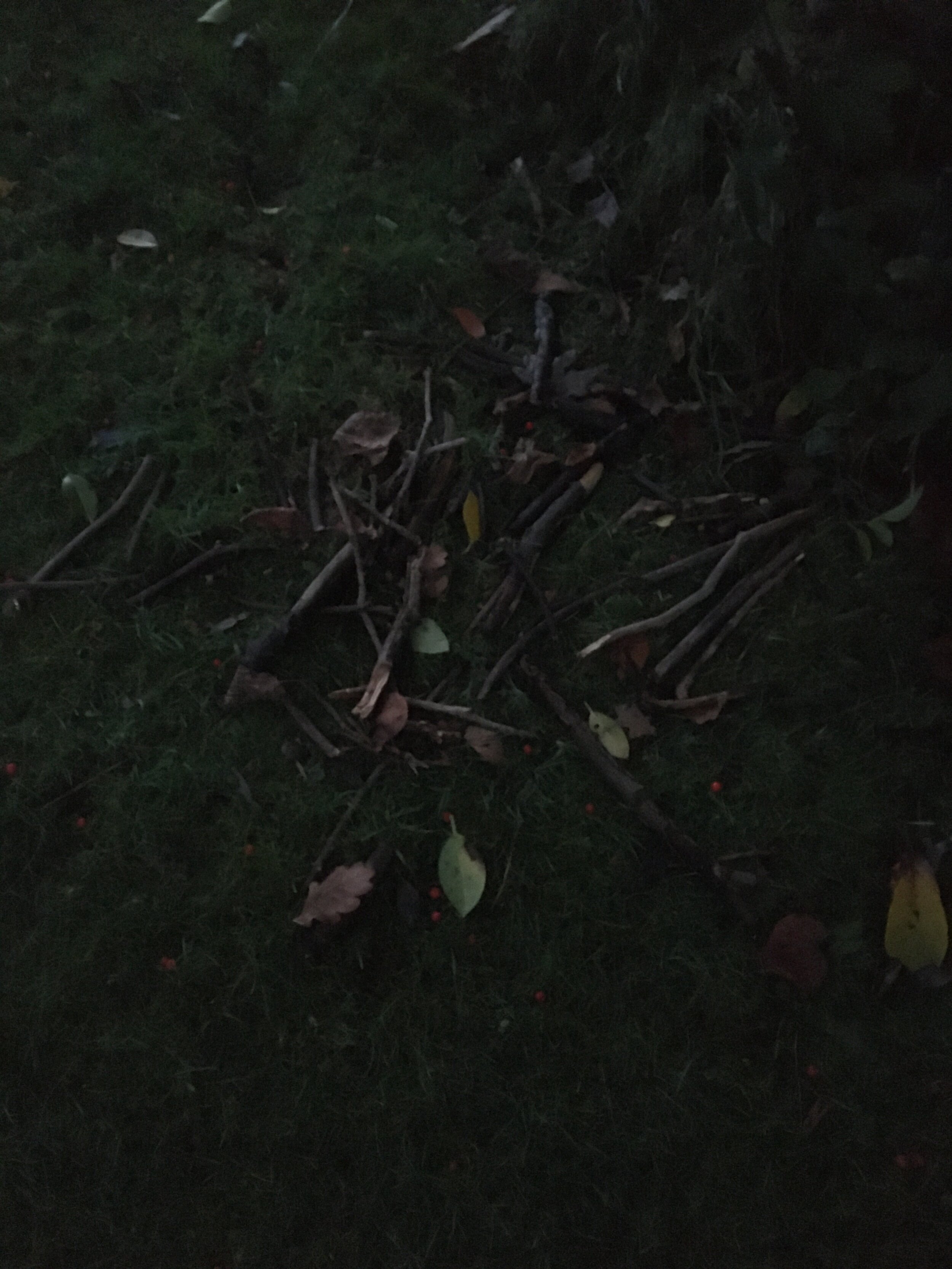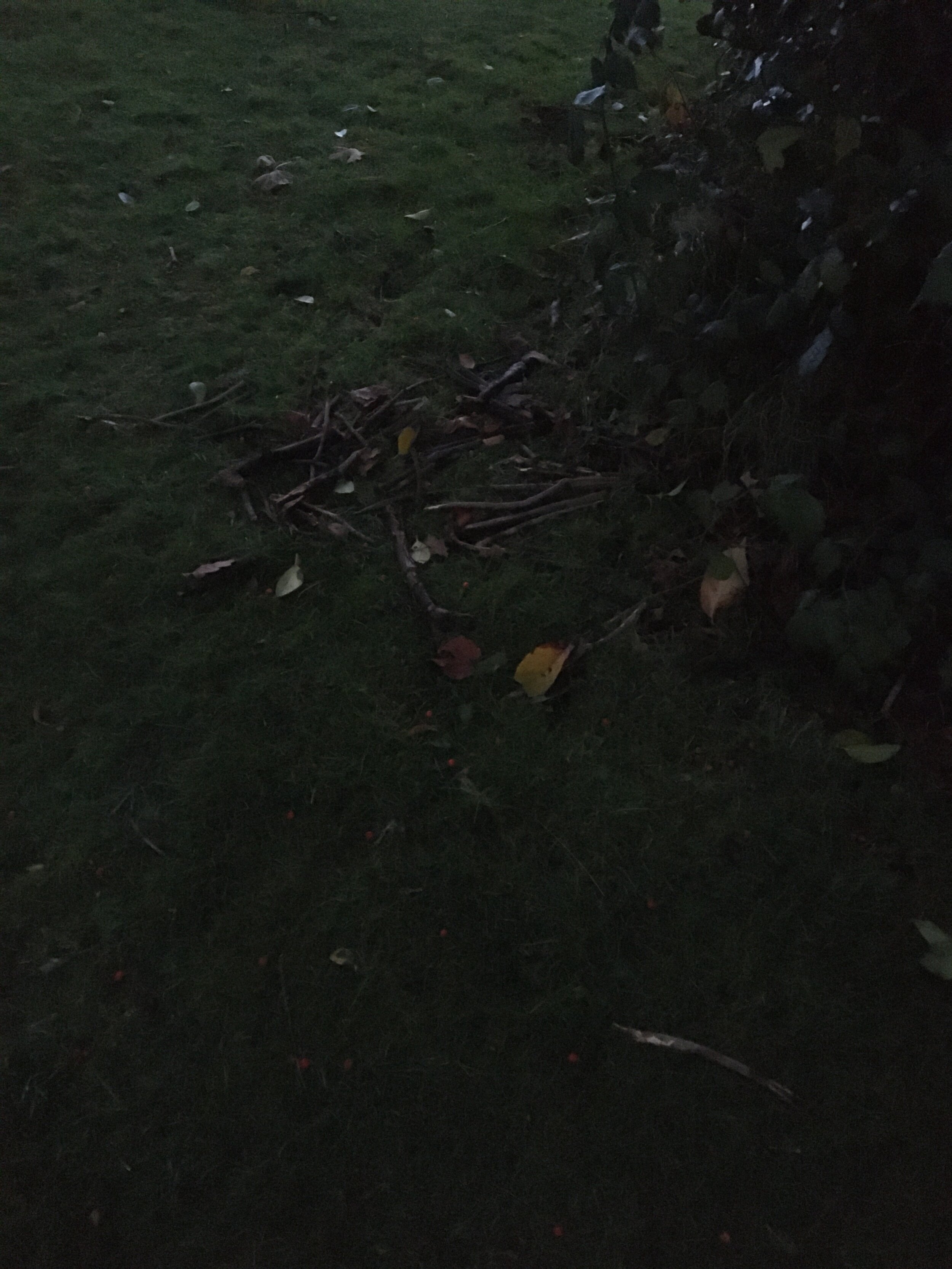A list of danger:
A disturbance.
A fight.
Arguments.
Harassment.
Agression.
Broken.
Kria.
Smash.
Bash.
Crash.
Rip.
Tear.
Tears.
That’s not fair!
Fears.
Blood.
Cancer.
Mutation.
Bruise.
Gash.
Stench.
Abject.
Mould.
Black.
Plume.
Dead.
Reek.
Parasites.
Snap.
A heavy fine.
The witching hour.
The devil on your shoulder.
Upon returning to my nesting site this week, I was met by the inevitable. A site disturbed:


There was of course no question that this moment was coming though I was met by sadness and disappointment. I was also met by the Darwinian truism that only the fortunate make it. I chose to give everything that I held about this place away to mask the upset. This concept informed a new song idea which for now, I name simply as “danger.” Following this song, I will share text, poetry and even Alfred Hitchcock’s “The Birds” as a reflection on all of the dangers that have a habit of “spitting out darker ink.”
When considering danger I am drawn to reflecting on its opposite, safety, and the connections between the two. When constructing my nest I referred to in my first blog post, I looked for a safe place away from pedestrians and business - attempting to stay away from outside forces that could pose danger to this delicate construction of safety. It was my fear of it being damaged or destroyed that directed my attention to a secluded place, hoping it would protect the nest in my absence. I came across the poem Ponderable, which speaks beautifully of the danger in leaving a nest and speaks of this interconnectedness between danger and safety:
A squirrel left the nest,
early this winter morning,
and as it climbed down the tree
its front paws outreached
as if feeling the air
to chart the way
toward the ground
as it has a thousand times
before today.
The squirrel’s eyes search
above, around, and down
watchful for predators
and dangers lurking everywhere,
though it can’t see the hawk
a quarter mile away
that is watching its every move
toward a fallen walnut.
Departing the nest
Is not an option,
though how and where
to go demands care,
and even when caution
is in the wind, dangers remain
unseen and unheard
until the first grasp and last gasp.
(George, J. 2020).
‘Departing the nest is not an option, though how and where to go demands care’ - is such a beautiful description of finding balance between safety and danger, constantly in flux and continuously in motion as I have reflected on in previous posts. We are continuously coming up against risky or dangerous decisions and events in our everyday and yet it is through those encounters we find what we consider to be safe. The line ‘dangers remain unseen and unheard until the first grasp and last gasp’ feels particularly connected to my list of danger and its unpredictable nature - almost everything on my list refers to the unexpected. I am interested in how safety feels so much more constructed, whilst I connect danger with the quick and unforeseen. The construction of my nest demanded a slow, considerate and delicate process whilst the destruction of it was most likely rapid and random. It is therefore interesting connecting that process with this idea of the construction of safety and the unpredictability of danger. When looking into this in more depth I came across a list on how to cope with fear, which is interesting when considering how danger often comes out of nowhere:
5 ways to cope with fear:
Pay attention
Give fear a shape
Focus on your present reality
Balance the negative with the positive
Get help
(Promises Behavioural Health, 2020).
You can only prepare for so much. This is good in some situations when coming up against danger but in other situations you simply cannot prepare for it. A bird may be vigilant and strategic with its nest building, defence strategies and protection and yet - a stormy day can sweep everything away.
Finally, I conclude that danger is directly connected to what we value the most; in a bird’s case the danger lies in the predator destroying their place of safety and therefore risking lives and future prospects, which is what the bird values the most. When I consider what danger means to me, I reflect on what I hold closely, what I place value on and what matters the most, or as beautifully described in an article on how to cope with fear:
Underlying our fear of danger is our love for life, our desire to stay here on Earth, to
protect our own safety and that of our loved ones.
(Mohr, T. 2019).
I wrote another song as a reflection on these ideas in this personal sense. Guard Dog is a song that is about trying to overcome a sudden bout of anxiety in a social situation - a danger of our modern times. I liked the idea of anxieties being like a Guard Dog, which over time you subconsciously train when to “attack” you when you’re in certain situations or places… I leave this song my departing dangerous thought, which is a little less imposing than the first track I shared in this post.
Alfred Hitchcock reminds us, albeit in the context of a psychological horror film, of how dangerous birds can be in the cult classic “The Birds.” The crows in this film display a similar “attack being the best form of defence” tactic on the people throughout and I thought of this when considering my list. Let us consider the action in the film clip below - to hit out rather than consolidate, in a desperate attempt to remain.
Flight and other active coping behaviours are responses to proximate threat, whereas passive coping strategies, such as freezing and stillness, are whats known as ‘conditioned responses’ to dangerous scenarios. These two strategies have distinct and successive roles, and are controlled by the environment and probability of success - whether or not there is a route of escape! Steimer continues this thought in his paper “The biology of fear - and anxiety-related behaviours:”
Thus, when an animal faces a predator, freezing is preferentially activated
when the source of known danger is still far away. When danger gets
closer, and the stimulus passes through some critical “psychometric”
distance, it becomes a true unconditional stimulus and a flight pattern is
activated.
(Steimer, T. 2002).
As I returned to my nest I was faced with a site of destruction, which spoke of my absence on the site and the presence of something else - a dog, a human or perhaps the wind. This disruption was unexpected but perhaps a part of the process, as I now reflect on my initial enquiry and desire to construct my nest.
References:
George, James A. 2020. “Ponderable” from All Poetry. Available from https://allpoetry.com/poems/about/Danger (Accessed November 28 2020)
Hitchcock, Alfred. 1963. “The Birds.” Universal. Clip available from: https://www.youtube.com/watch?v=hplpQt424Ls&ab_channel=Movieclips (Accessed December 10 2020)
Mohr, Tara. 2019. Playing Big: A practical guide for brilliant women like you. Arrow, 3rd Edition.
Promises Behavioural Health. 2020. “5 Ways to Cope With Fear in an Increasingly Scary World.” Available from: https://www.promisesbehavioralhealth.com/addiction-recovery-blog/5-ways-to-cope-with-fear-in-an-increasingly-scary-world/ (Accessed November 28 2020)
Steimer, Thierry. 2002. “The biology of fear- and anxiety-related behaviors” As found in: Dialogues Clin Neurosci. 2002 Sep; 4(3): 231–249. doi: 10.31887/DCNS.2002.4.3/tsteimer. Available from: https://www.ncbi.nlm.nih.gov/pmc/articles/PMC3181681/ (Accessed November 28 2020)
